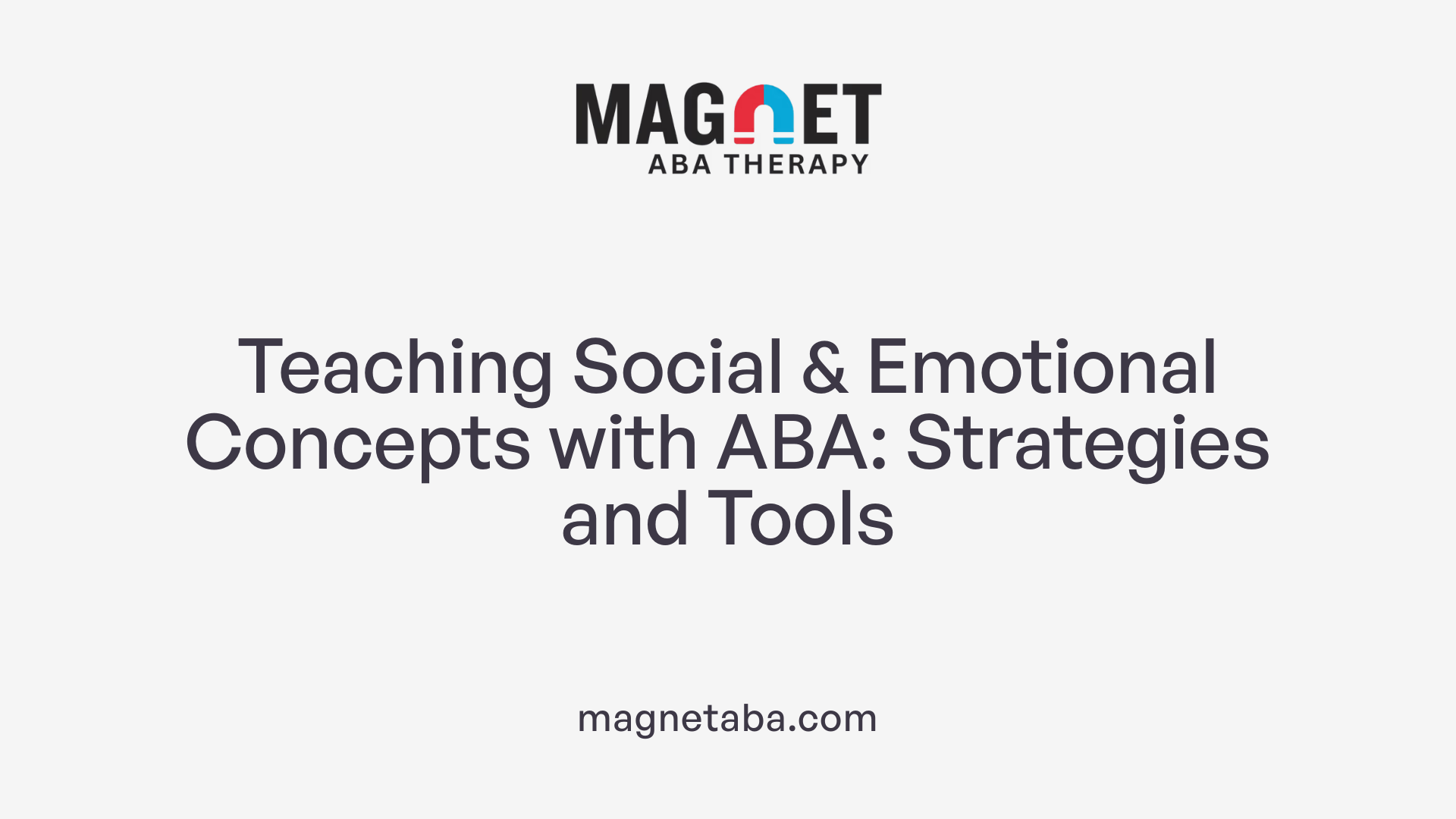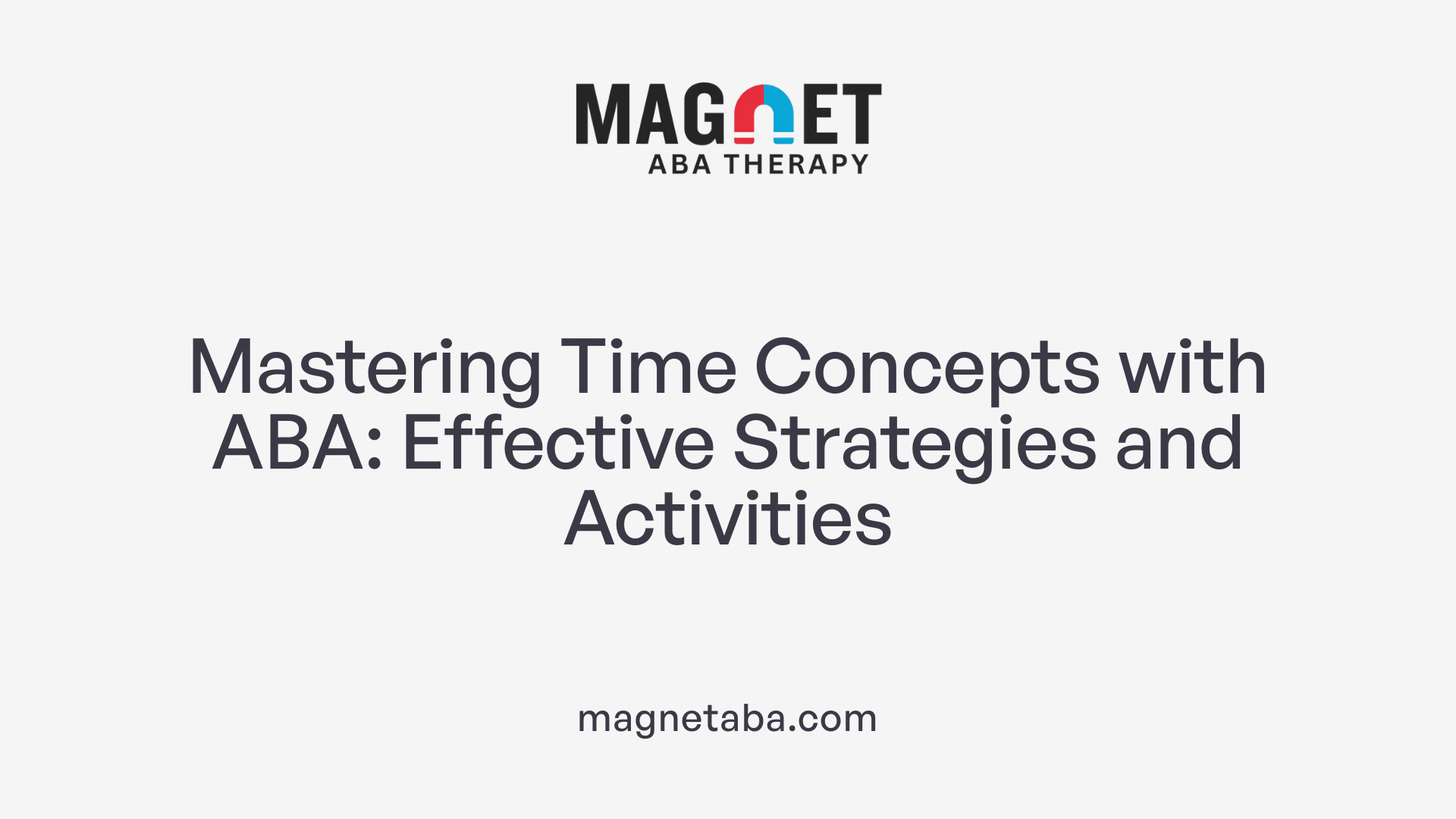Bridging the Gap in Abstract Concept Teaching Through ABA
Teaching children, especially those with autism, complex and abstract concepts such as time presents unique challenges. Applied Behavior Analysis (ABA) offers a structured, evidence-based framework for making these concepts accessible and understandable. This article explores practical tools, effective strategies, naturalistic methods, and adaptations of ABA techniques to facilitate learning of abstract ideas, with a focus on the concept of time, emotional understanding, and social boundaries.
Practical Tools and Visual Supports in ABA
 In applied behavior analysis (ABA), helping children grasp complex abstract concepts requires the strategic use of various visual supports and hands-on activities.
In applied behavior analysis (ABA), helping children grasp complex abstract concepts requires the strategic use of various visual supports and hands-on activities.
Visual supports such as graphic organizers, photos, and cause-and-effect diagrams serve to make intangible ideas more concrete. For example, adapted books with pictures and simple text can illustrate emotions, routines, or sequences, making these concepts easier to understand and remember.
Using tangible materials like building blocks, role-playing props, or sensory toys adds a tactile dimension to learning. Engaging multiple senses enhances comprehension and retention, especially for children who benefit from hands-on approaches.
Social stories are another valuable tool. These short, illustrated narratives describe social situations and expected behaviors, helping children understand social cues and emotional responses within predictable routines.
Consistent routines and repetition are essential. Repeating activities and using clear, predictable sequences enable children to internalize new skills and generalize learning across different settings.
Activities like role-playing and social skills exercises provide practical opportunities for children to practice and internalize complex social behaviors. These methods help bridge the gap between understanding and applying concepts in real-life interactions.
| Tool/Technique | Description | Example |
|---|---|---|
| Visual Supports | Diagrams, photos, graphic organizers to illustrate ideas | Emotion charts, sequencing cards |
| Tactile Activities | Hands-on play to reinforce learning | Building models, role-play scenarios |
| Social Stories | Narratives explaining social cues and routines | Stories about greeting, sharing, or asking for help |
| Structured Routines and Repetition | Repeating key activities to promote mastery | Daily schedules, transition cues |
Educators and caregivers can combine these tools to create engaging, multi-sensory learning experiences. This fosters understanding of both concrete and abstract concepts, promoting meaningful skill development in children with autism.
Using ABA Strategies to Teach Social and Emotional Abstractions

What are effective ABA strategies for teaching abstract social and emotional concepts?
Applying ABA methods to teach social and emotional ideas involves a set of structured, evidence-based strategies tailored to individual learners. Visual supports like social narratives and the Zones of Regulation play a significant role in increasing awareness and emotional regulation.
Social narratives are personalized stories that help children understand specific social situations, expected behaviors, and emotional responses. They create a visual and verbal framework that simplifies complex social concepts, making them more accessible.
Similarly, the Zones of Regulation is a visual tool that categorizes emotions into different color-coded zones, helping children identify and regulate their feelings. By explicitly teaching children to recognize their emotional states and choose appropriate responses, these tools foster emotional self-awareness.
Role-playing, modeling, and structured scripts are additional techniques that promote understanding and practice of social interactions. In role-playing, children act out scenarios to learn social skills in a controlled, supportive environment. Modeling involves demonstrating desired behaviors, allowing children to observe and imitate.
Structured scripts provide a step-by-step guide for engaging in social exchanges, such as greeting others or requesting help. These scripts can be gradually faded as the child gains confidence.
Reinforcement and generalization are crucial components. Positive reinforcement encourages children to demonstrate and repeat learned behaviors. To ensure the skills transfer across various settings and people, ABA practitioners use techniques like prompt fading, varied materials, and diverse environments.
Prompt fading involves gradually reducing prompts or cues used to elicit a correct response, promoting independent skill use. Errorless learning minimizes mistakes during teaching, boosting confidence and mastery.
Combining these strategies with data collection allows practitioners to monitor progress, tailor interventions, and adapt techniques to meet individual needs. This comprehensive approach supports the development of social and emotional skills, enabling individuals with varied abilities to navigate complex social environments successfully.
Applying Naturalistic ABA to Teach Abstract Ideas

How can naturalistic ABA methods be applied to teach children about abstract ideas?
Naturalistic ABA focuses on embedding learning opportunities into a child's daily routines and play, making abstract concepts more accessible and relevant. Instead of traditional structured instructions, this approach uses child-led, interest-based interactions that naturally fit into everyday moments.
For example, to teach the concept of time, therapists or parents might incorporate activities like looking at a daily schedule or engaging in storybooks that emphasize sequencing and routines. These activities are more meaningful because they align with what the child already enjoys and understands.
Techniques such as incidental teaching involve observing the child's interests and strategically introducing learning moments during those activities. For instance, if a child is interested in animals, the caregiver might introduce related vocabulary or time-based concepts through conversation or play centered around animals.
Pivotal response training (PRT) further enhances learning by focusing on pivotal areas such as motivation and response to multiple cues. When a child shows interest, caregivers can expand the activity to include new vocabulary or social rules, reinforcing the concept naturally.
Integrating real-life contexts—like routines, social outings, or play environments—helps children connect abstract ideas with tangible experiences. For example, using outdoor activities like raking leaves or scavenger hunts can teach causality and the passage of time, making these ideas concrete.
Environmental manipulation also plays a role, such as using visual schedules, timers, or storybooks that show sequences, to help children understand transitions and the flow of events.
Most importantly, naturalistic ABA encourages generalization across settings. Skills learned in therapy are transferred to home, school, and community environments, ensuring that children can apply concepts like social boundaries, emotional understanding, and temporal awareness in everyday situations.
In summary, naturalistic ABA methods teach children about abstract ideas by embedding them into meaningful, interest-driven activities, making learning relevant and engaging. This holistic approach promotes understanding that extends beyond therapy sessions, fostering real-world skills and independence.
Teaching Time Through ABA: Strategies and Activities

How can ABA be used to teach abstract concepts like the passage of time?
Applied Behavior Analysis (ABA) offers effective methods for teaching children with autism about abstract concepts such as the passage of time. Because time is intangible, educators and therapists break it down into smaller, manageable steps. This approach involves setting clear, measurable objectives and using specific behavioral strategies.
Naturalistic teaching techniques, such as incidental teaching, play a vital role. These methods embed learning within everyday routines and activities that children naturally encounter, making the concept of time more relevant and tangible. For example, outdoor activities like raking leaves or scavenger hunts provide concrete experiences where sequencing and causality can be demonstrated.
Using stories and daily routines—like cooking or brushing teeth—helps children understand sequences and the idea that certain actions happen before or after others. Visual supports such as picture schedules, timers, and sequencing cards visually represent the flow of events, reinforcing the concept of passage and order.
Technology can further support this learning. Smartphone apps like Peekaboo Barn or Toca Tea Party incorporate timing and sequencing activities in a fun, interactive way. These digital tools introduce an engaging component to reinforce understanding.
Supporting the development of causality and sequencing is vital. Teaching children that actions lead to results (e.g., turning a page leads to a story) reinforces their grasp of how time passes and events are related.
Incorporating emotional and developmental strategies, such as Floortime, can enhance comprehension by building emotional connections to activities involving time. Engaging children in meaningful, shared experiences makes the abstract concept of time more accessible and memorable.
In sum, combining ABA techniques with real-life routines, visual aids, digital tools, and emotional engagement provides a comprehensive approach to teaching the passage of time, fostering both understanding and practical skills.
Adapting ABA for Understanding Abstract Ideas in Children with Autism
Applying ABA techniques to help children, including those with autism, grasp abstract concepts like time requires thoughtful adaptation and personalized strategies.
One effective approach involves using visual supports such as schedules, cues, and task analyses. These tools visually break down routines and sequences, making abstract ideas more concrete. For example, visual schedules can depict daily routines or the passage of time with pictures or symbols, aiding children in understanding expectations and the flow of activities.
Naturalistic teaching methods also play a vital role. These strategies involve embedding learning opportunities within real-life environments, encouraging children to generalize their understanding across settings. During daily activities, caregivers and therapists model behaviors, prompt responses, and provide positive reinforcement to reinforce the concept of time and its passing.
Personalized assessments are essential for tailoring interventions effectively. By evaluating each child's developmental stage, learning style, and interests, educators can create individualized visual or tangible representations of time. For instance, using physical timers, clocks, or storyboards helps children connect with the abstract notion of time more intuitively.
Fostering comprehension also involves developing personalized plans that incorporate these visual aids, structured routines, and engaging activities. For example, combining story-based activities with digital or physical tools can make learning about time engaging and relevant.
Incorporating these adaptations within the framework of ABA ensures that children with autism can develop a better understanding of abstract concepts, ultimately supporting their independence and daily functioning in social and educational contexts.
| Strategies for Teaching Time | Tools Used | Goals |
|---|---|---|
| Visual schedules and cues | Pictures, symbols, storyboards | Illustrate routines and sequence |
| Naturalistic teaching | Real environment, modeling, reinforcement | Promote generalization |
| Personalized representations | Clocks, timers, tangible aids | Make abstract ideas concrete |
| Structured routines and activities | Digital apps, arts, and crafts | Reinforce temporal understanding |
These methods underscore the importance of blending visual supports, real-life context, and individual needs to effectively teach children with autism about the passage of time and related abstract concepts.
Enhancing Learning Through Customized ABA Approaches
Teaching abstract concepts like time with ABA requires a multifaceted approach that integrates visual supports, naturalistic methods, structured routines, and personalized interventions. By making abstract ideas tangible through visual aids, real-life activities, and engaging strategies, practitioners can foster meaningful understanding and facilitate generalization across different settings. Incorporating evidence-based practices such as Floortime, social narratives, and apps can further enhance emotional and social comprehension. As research continues to evolve with larger-scale studies, the core principle remains: tailored, engaging, and systematic ABA interventions best support children in mastering complex abstract concepts, paving the way for improved communication, social skills, and independence.
References
- Introducing LADER: A Structured Approach to Effective ...
- Applied Behavior Analysis in Children and Youth with ...
- Floortime
- Teaching Kids to Identify Their Emotions with ABA
- How to Teach the Concept of Time to Young Children ...
- Incorporating ABA Techniques Into Everyday Life for ...
- Floortime
- How to Use ABA in the Classroom












